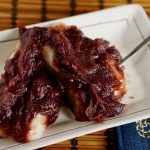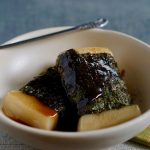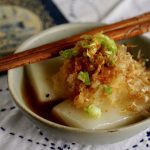Summary
One of Japan’s most traditional foods, mochi is now widely eaten all around the world.
Mochi plays a central role during the Japanese New Year festivities – and if I don’t eat mochi for New Year’s, it’s not really New Year’s!
Read on to find out more about this celebrated Japanese food.
What is mochi?
Mochi is a rice product used as a snack in Japanese washoku.
Mochi is made by pounding steamed glutinous rice (mochi gome), and then molding the gooey mass into a rice cake. Mochi can also be made from mochiko or shiratamako, which are different kinds of glutinous rice flour, however this method yields a different consistency to that of the pounded version. Pounded mochi is said to retain more of the sweet rice flavour, and is dense and chewy, lending itself well to large or thick shapes in both sweet and savoury recipes. Mochi made from glutinous rice flour is more pliable and soft, so it is more often used for smaller shapes, desserts, or wrapping something delicate, like ice cream.
Incidentally, ‘mochi’ does not refer to ‘mochi ice cream’. When Japanese people hear the word mochi, they think of the plain, gooey, rice-tasting mochi, not the sweet ice cream filled variety widely popular here in North America.
Mochi tsuki, or the tradition of pounding glutinous rice into mochi, is one that families across Japan still uphold during the New Year season. Steamed mochi gome is placed in a traditional pestle (usu) and pounded with a wooden mallet (kine). Mochi tsuki is a team effort, requiring one or two people to pound the mochi in turn, while a third person reaches in regularly to fold the mochi and check the texture. Check it out here!
Although mochi tastes fairly plain, this makes it the perfect canvas for a variety of flavour pairings, such as sweet red bean paste or savoury soy sauce and nori. But the best part about mochi is its unique texture. Depending on whether it’s boiled, grilled or served in soup, the surface could range from soft and melty to hard and crispy. But the heart of mochi remains the same: its springy, squidgy, gooey, chewy mochiness! The texture is so unique that the term mochi-mochi is also used to refer to anything with a similar soft or springy feel, such as freshly baked bread, pudgy baby cheeks, or a squishy plush toy.
A brief history of mochi
It is said that the culture of mochi came from China and Southeast Asia, along with rice culture. In ancient Japan, rice cultivation was strongly influenced by the climate, so people believed that rice was grown by the power of the gods, who control nature. Therefore, mochi was used as an offering to the gods during festivals and Shinto ceremonies. It was believed that eating mochi could bring the power of the gods into the body – but mochi was initially a food only eaten by the emperor and nobles. The nobles considered mochi a symbol of good fortune, long life and well-being. Today, all classes can share in the blessings of eating mochi!
On New Year’s Day, the god of the New Year is said to come to each family to bring happiness for the coming year. Families place kagami mochi (meaning ‘mirror rice cake’) on their altar, a tradition still commonly upheld. Kagami mochi is made up of two large round mochi buns piled one on top of the other, with a daidai (bitter orange) on top. Their round shape is said to be reminiscent of an old-fashioned copper mirror, which has religious significance, hence the name kagami.
Kagami mochi is used to decorate one’s home from December 28 (considered to be a good luck date), until kagami biraki, the “mirror opening” day (usually January 11). Cutting the kagami mochi open with a knife has negative connotations (e.g. the ritual act of seppuku!), so it is common practice to “open” it by hand or with a wooden stick. As mochi hardens over time, people usually add the dry kagami mochi into soup to soften it before eating.
Over the years, various specialty mochi creations have been added to the roster of its traditional uses, and mochi culture has spread from Japan to all over the world!
East, West, home-style’s best!
Within Japan, the specific cultures and practices surrounding mochi vary from region to region. Two main parties provide the largest contrast in terms of many Japanese food traditions: the East (Tokyo and the Kanto region) and the West (Kyoto and the Kansai region).
As for mochi, this difference is mainly seen in its shape! Mochi usually comes in two basic shapes: the maru (round) mochi of Kansai or the kaku (square) mochi of Kanto.
Kyoto is the birthplace of ozoni, a traditional New Year’s soup including mochi. Kansai or Kyoto-style ozoni contains round (marui) buns of mochi, hand-rolled one by one. Maru mochi represents the harmony of the cornerless circle, a shape that was considered sacred as the source of life. Needless to say, cutting it to make it square would be worse than bad luck.
The growing population of eastern Japan during the Edo period gave rise to the convenience of the square kaku mochi, which could be made in large numbers at a time. The Kanto region also had a long period of samurai rule, and it is said that the pre-cut kaku mochi in Kanto-style ozoni may have been considered a symbol of cutting down one’s enemies, making it a lucky food to eat before going to war.
Who knew something as simple as the shape of rice cake could be so revelatory of culture! Other Kanto and Kansai mochi differences include whether the mochi is usually grilled (Kanto) or boiled (Kansai), and the type of ingredients added to common mochi dishes. Ultimately, there is no right shape or flavour. I would say the best mochi is the kind that tastes like home 🙂
Conclusion
As described above, mochi is originally a Japanese food used for special occasions such as New Year’s and festivals. Nowadays however, you can eat mochi daily, regardless of the season or event! In fact, many homes keep packaged mochi as emergency food in the event of a disaster, as Japan is prone to its fair share of typhoons and earthquakes. Basically, mochi is an appropriate food choice for the best of times, the worst of times, and everything in between.
Personally, I love mochi ice cream and often eat it. If you do too, just remember that there’s a rich culture and history backing up its deliciousness.
Here are 3 traditional recipes you can try for New Year’s – or really any time you’re craving a mochi snack!


